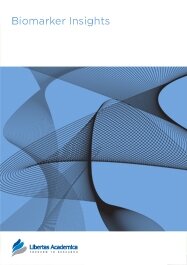

Publication Date: 04 May 2010
Type: Short Report
Journal: Biomarker Insights
doi: 10.4137/BMI.S4530

Reductions in fasting serum fructose or erythrocyte sorbitol have been proposed as markers for early proof of mechanism in clinical development of aldose reductase (AR) inhibitors. However fructose is significantly impacted by meals and evaluation of erythrocyte sorbitol poses technical challenges. To more accurately assess the performance of these markers in biological samples, a gas chromatography-mass spectrometry assay was modified and validated. Serum was collected on three consecutive days from 13 healthy volunteers (HV) and 14 patients with type 2 diabetes mellitus (T2DM), and assayed for sorbitol and fructose using this assay. Serum fructose and sorbitol were relatively constant across the three days. Fasting fructose levels were comparable between the two groups (T2DM: 1.48 ± 0.49 mg/L; HV: 1.39 ± 0.38 mg/L, mean ± standard deviation, P = 0.61), but fasting sorbitol levels were significantly higher in diabetics (T2DM: 0.280 ± 0.163 mg/L; HV: 0.164 ± 0.044 mg/L, P = 0.02). Feeding resulted in a 5–6 fold increase in serum fructose levels, but only a 5%–10% increase in sorbitol. Only sorbitol remained significantly elevated pre- and post feeding in T2DM patients relative to HV. These data suggest that serum sorbitol may be a robust proof of mechanism biomarker and facilitate dose selection for clinical development of AR inhibitors.
PDF (539.73 KB PDF FORMAT)
RIS citation (ENDNOTE, REFERENCE MANAGER, PROCITE, REFWORKS)
BibTex citation (BIBDESK, LATEX)
XML
PMC HTML

I have had a great experience with submitting my cancer prognosis study to Biomarker Insights. The comments from reviewers and associate editor are high quality and insightful. Congratulations and keep up the good work.

All authors are surveyed after their articles are published. Authors are asked to rate their experience in a variety of areas, and their responses help us to monitor our performance. Presented here are their responses in some key areas. No 'poor' or 'very poor' responses were received; these are represented in the 'other' category.See Our Results
Copyright © 2013 Libertas Academica Ltd (except open access articles and accompanying metadata and supplementary files.)
FacebookGoogle+Twitter
PinterestTumblrYouTube